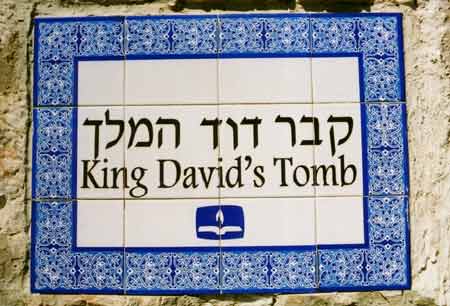Jerusalem Archaeological Sites: King David's Tomb
David, youngest son of Jesse of the Ephrathite family that lived in Beth-Lehem in Judah (I Sam. 16:1; 20:27–28; I Chron. 2:13–15; cf. Micah 5:1). According to the Book of Ruth (4:17, 20–22), David was descended from Ruth the Moabitess, the wife of Boaz of the family of Perez (cf. I Sam. 22:3–4). David reigned 40 years (c. 1010–970 B.C.E.), seven years and six months of them over Judah in Hebron and thirty-three years over all Israel and Judah in Jerusalem (II Sam. 5:4–5).
According to the Bible, David was buried in the "City of David" presumably in the southeast of the present Siloam area (I Kings 2:10). Traditionally the later kings of the Davidic dynasty were also buried there and the Bible refers to the "sepulchers of the sons of David" (II Chron. 32:33), whose site was still known in the time of Nehemiah (Neh. 3:16). The tombs were in Jerusalem, but were never touched (Tos. B. B. 1:11). According to Josephus, Herod broke into David's tomb to rob it, but when he tried to go into the inner chamber tongues of fire shot out (Jos., Ant., 16:7:1). The site is also mentioned in the New Testament (Acts 2:29).
The tomb of David was probably destroyed at the time of the Bar Kokhba revolt (135 C.E.), and afterward the exact location of the site was forgotten. However, various sites were suggested by popular traditions over the ages and the one which became generally accepted was the place now called Mt. Zion. This tradition is about 1,000 years old, first being recorded in Crusader times, and was accepted in Jewish, Muslim, and Christian traditions. Benjamin of Tudela (c. 1173) reports a story about the miraculous discovery of David's tomb on Mt. Zion during the repairing of a church on the site. The site was in the hands of Muslims and Christians at various periods and came under Jewish control after the Israel War of Independence in 1948. It became a special center for Jewish pilgrims in the period from 1948 to 1967 because the most revered Jewish site, the Western Wall, was not accessible to Jews and David's Tomb was the closest point to the Old City of Jerusalem. Oriental Jews especially made pilgrimages to the site on all three festivals and particularly on Shavuot, the traditional date of David's death.
Sources: http://www.centuryone.org/davtomb.html; Encyclopedia Judaica; Photo source:© Jack Hazut. No reproduction allowed without written permission from Jack Hazut and AICE.



